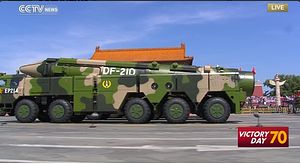Beijing’s grand military parade to commemorate the 70th anniversary of the surrender of Japan and the end of the Second World War involved more than 12,000 troops from the Army, Navy, Air Force, Second Artillery Force, and Armed Police marching down Chang’an Avenue by Tiananmen Square, along with approximately 500 military vehicles and around 200 aircraft.
Notably, in his pre-parade keynote speech, delivered from a podium overlooking Tiananmen Square, Chinese President Xi Jinping announced cuts in the size of the military. “I announce that China will reduce military personnel numbers by 300,000,” he said while noting that the People’s Liberation Army (PLA) is “loyally committed to its sacred duty of defending the security of the motherland and the peaceful life of the people, and loyally committed to the sacred duty of safeguarding world peace.”
The force reduction would constitute an approximately 13 percent cut in the active duty strengths of the 2.3 million strong Chinese military. However, Xi did not indicate when the planned reduction in size might begin. The largest reduction of PLA manpower in China’s recent history occurred in 1997 when a cut of 500,000 troops was announced.
The parade also involved 1,000 foreign troops from 17 countries, including 75 members of the elite Russian 154th Infantry Regiment, which had the honor of being the last marching phalanx passing Tiananmen Square and concluding the massive military spectacle.
Foreign attendees included, Russian President Vladimir Putin, South Korean President Park Geun-hye, United Nations Secretary-General Ban Ki-moon, former British prime minister Tony Blair, former German chancellor Gerhard Schroeder, and Sudanese President Omar al-Bashir, indicted by the International Criminal Court for crimes against humanity – “an old friend of the Chinese people” in the words of Xi Jinping.
With the parade, Chinese President Xi Jinping sought to showcase his and the Chinese Communist Party’s strong command over the PLA to a domestic audience. Meanwhile, the display of some of China’s most modern military hardware served the more traditional purpose of deterring potential foreign aggressors. (According to Chinese media, 84 percent of the military hardware displayed at the parade had never been previously viewed by the public.)
In that respect, the large number of Chinese missiles that were paraded down Chang’an Avenue was of particular interest. All were labeled with white Latin letter abbreviations, perhaps in part to make sure that foreign observers can more easily identify Beijing’s deadly missile arsenal.
As expected (See: “Revealed: China for the First Time Publicly Displays ‘Guam Killer’ Missile”), the parade featured a variety of missiles from the Dong Feng (DF, East Wind) series such as the DF-15B short-range ballistic missile (SRBM), the DF-16 medium-range ballistic missile (MRBM), the DF-21C MRBM, the DF-5B intercontinental ballistic missile (ICBM), the DF-31 A ICBM, the DF-10 land-attack cruise missile (LACM), and the DF-26 intermediate range ballistic missile (IRBM).
The DF-26 IRBM is allegedly capable of striking U.S. military installations on Guam (as well as medium-sized maritime targets) and the DF-16 MRBM can purportedly reach Okinawa. One of the ICBMs displayed – the DF-5B – is apparently equipped with multiple independently targetable re-entry vehicles (MIRVs), while the DF-31A boosts a maneuverable reentry vehicle (MARV) capable of shifting targets in flights. Notably absent from the parade grounds was China’s newest ICBM – the DF-41 (See: “China Tests New Missile Capable of Hitting Entire United States”).
Of special interest to the U.S.-based crowd of Anti-Access/Area Denial (A2/AD) military analysts was a special “Anti-Ship Missile Formation” that included, among other things, the Yingji (YJ)-12 antiship cruise missile (ASCM), the YJ-83 (ASCM) and, most interestingly, the DF-21D ASBM – dubbed a “carrier killer” missile with the alleged capability of hitting large ships in the Western Pacific. However, China’s most modern supersonic anti-ship missile, the vertically launched YJ-18 was not on display in Beijing today, which could indicate that the weapon is not in service yet.
Among the aircraft, the parade most notably featured five J-15 carrier-based fighter jets that flew over the parade ground.
































